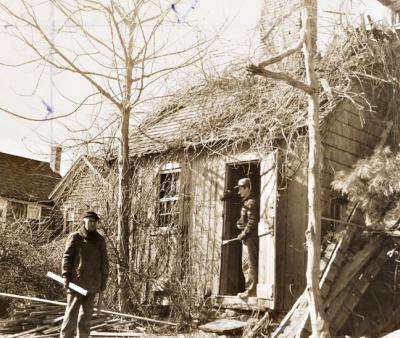History of Two Sorts in Further Lane Record Sale

The eye-popping price reportedly paid in the recent sale of 16 acres at 60, 62, and 64 Further Lane in East Hampton Village has attracted the most attention, but the status of two historic landmarks on the property is of greater importance to preservation advocates.
According to the New York Post, Barry Rosenstein, a hedge fund manager and founder of the multibillion-dollar Jana Partners (and before that, Sagaponack Partners), has purchased the property for $147 million, making it the most expensive residential property in the United States. But also significant is a small timber-framed structure situated on the lot at 62 Further Lane, and what will become of it.
The Dominy clock and woodworking shops, respectively dating to around 1797 and 1850, stood on North Main Street in East Hampton from the time of their construction until 1946. Several generations of the family, including Nathaniel Dominy IV, his son Nathaniel V, and his grandson Felix, were renowned for their woodworking and clock and watch-making skills.
In 1946, the two buildings were in disrepair and about to be demolished when Dudley Roberts, the late founder and president of Cinerama Productions and the investment banking firm Roberts & Company, rescued them. He moved them to 62 Further Lane, which he owned, and combined them into a single structure.
Elizabeth Fondaras was the owner of the property in 1996 when Christopher Browne, managing director of the investment banking company Tweedy, Browne, bought it from her. Mr. Browne died at 62, of a heart attack, in 2009, leaving most of his estate to his partner, Andrew Gordon, who lived there until his death in September. The properties were held after Mr. Browne’s death in trusts created by him. A number of family members, two friends, and his chef were reported at the time to have challenged his will.
Mr. Rosenstein bought the property directly from the family, according to The Post, bypassing brokers. Local observers have speculated that the main house, a Modernist building designed by Mr. Gordon, an architect, will be torn down and a new one constructed.
“The survival of the Dominy records, Dominy tools, and even the partial survival of the shops, is unique,” said Charles Hummel, curator emeritus ofthe Winterthur Museum, Garden and Library in Delaware, which houses reproductions of the two shops as well as more than 800 of the Dominys’ tools, machinery, templates, and other objects representative of their work. “There is nothing else like it that has survived in the United States relating to a family or group of craftsmen that worked both in the colonial period and in the period of the new republic,” Mr. Hummel, a leading researcher on the Dominy craftsmen, said. “When I was asked to lecture by the Regional Furniture Society in England five or six years ago, they said there was nothing like it that survived in the U.K. as well. So [the shops] have incredible importance.”
While Mr. Roberts saved the structures from demolition, said Mr. Hummel, “by caving in the sides of both shops and combining them into one, a lot of important evidence was destroyed.” Yet, he said, “I’ve been inside those shops, and there are still some important pieces of evidence surviving.”
Despite their age, the structures are in surprisingly good condition, said Richard Barons, executive director of the East Hampton Historical Society, who has also inspected them from inside. “We were startled at how carefully they were moved, and every little shelf or bracket was still on the walls,” he said. “They are little jewels.”
As one of 25 structures designated timber-frame landmarks by East Hampton Village, said Robert Hefner, the village’s historic preservation consultant, the joined buildings cannot be torn down. “Changes to it are subject to approval by the Design Review Board,” he said.
Like Mr. Hummel and Mr. Barons, Mr. Hefner said he would like to see the buildings returned to their original location. “The village has been interested for a long time in preserving these buildings, putting them back where they were,” he said. “They are nationally important.”
In fact, said Mr. Barons, Mr. Browne had discussed donating the structures to the village. “When Chris died, all that stopped,” he said. “All of us would be pretty excited if those things could be brought back.”
